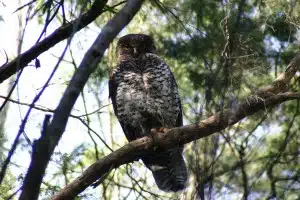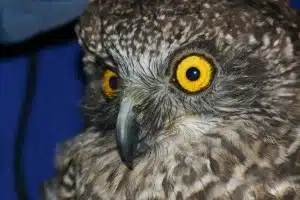
Fiona Hogan with a male powerful owl in suburban Melbourne. Credit: John White, Deakin University
Dr Fiona Hogan is DNA fingerprinting Australian owls with the help of feathers and a keen public.
Her work is transforming our understanding of the night life of owls, normally notoriously secretive.
From a single feather, this Deakin University researcher can determine the species, sex, and identity of individual birds. She has already found a pair of powerful owls who have mated together for at least 10 consecutive years, and that those breeding in urban areas are typically more closely related than those which breed in the bush.
“Being able to identify individual animals in the wild with DNA has transformed our work. It provides such a wealth of information that it has become the key to conservation,” she says, speaking at Fresh Science at Melbourne Museum.
Australian owls are under threat. Owls are predators. They are at the top of the food chain, and an essential part of the Australian environment. “Without them we could lose many native animals forever, because they help keep species in balance,” Fiona says. “In order to conserve owls we need to know more about them and we need that information fast.”

Male powerful owl in Warrandyte State Park. Credit: Fiona Hogan, Deakin University
So she has perfected the art of extracting DNA from feathers shed by the birds. “Trace amounts of DNA left behind by an animal, in feathers, hairs, scats or eggshells, can be used to identify them,” Fiona explains. “DNA in living organisms is unique and can be used to identify individuals using fingerprint techniques.”
Fiona has uncovered a series of ‘genetic markers’ which can provide a DNA fingerprint to identify an individual owl from a single feather.
As feather collection requires little expertise, Fiona has been able to enlist the aid of the people all over Australia to collect owl feathers for her. In total, more than 2,000 feathers have been collected, some from highly threatened species, such as the elusive Rufous owl (Ninox rufa) which is only found in remote areas in Northern Queensland and the Northern Territory.
Her techniques have sparked great interest worldwide, and her methods have been adopted in many other places.
“We now have access to such a wide range of useful and affordable technologies, which allow conservation biologists to obtain data much more quickly and precisely than using traditional techniques,” Fiona said.
Fiona Hogan is one of 15 early-career scientists presenting their research to the public for the first time thanks to Fresh Science, a national program sponsored by the Federal Government. She is a lecturer in Deakin University’s School of Life and Environmental Sciences, based in Melbourne.
Other stories released today:
- One step closer to treat cancer via gene-silencing; and
- Ancient eruptions warn of climate change and mass extinctions
For further information: fiona.hogan@deakin.edu.au
For Fresh Science contact: Sarah Brooker on 0413 332 489 and Niall Byrne on 0417 131 977 or niall@freshscience.org.





 Fresh Science is on hold for 2022. We will be back in 2023.
Fresh Science is on hold for 2022. We will be back in 2023.